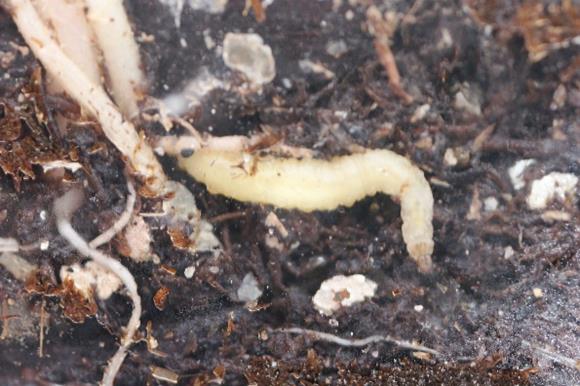
- Overall, unlikely that 2014-15 will adversely affect corn rootworm egg survival
- Multiple factors effect rootworm egg mortality
- If you saw declining pressure in 2014, populations may take time to rebound
- Watch corn-following-corn fields, especially if the 2014 crop matured late
- If beetles populations were low July-Aug 2014, rootworm pressure will likely remain low this year
Corn rootworms survive the winter in the egg stage at various depths in the soil. Dr. Mike Gray, while a graduate student at Iowa State University, found that female rootworm beetles laid about 21 percent of rootworm eggs within 4 inches of the soil surface, about 45 percent of the eggs were laid between 4 and 8 inches deep in the soil, and about 34 percent of the eggs were laid between 8 and 12 inches deep in the soil. Even when worm holes or drought cracks provide convenient entry to soil depths, rootworm eggs are rarely placed as deep as 18 inches.
Depth of rootworm egg placement and tillage have a significant effect on rootworm egg winter survival. In the 1980s, Eric Lawson, a graduate student of Dr. Jon Tollefson at Iowa State University, was able to determine a soil temperature regression for rootworm egg survival. He calculated that -1 degree Celsius (30.2 degrees Fahrenheit) was the threshold temperature, with 100 negative degree days causing a significant amount of mortality of rootworm eggs. What this means is that soil temperature of -1 degree Celsius (about 30 degrees F.) for 100 days, or 20 days at -5 degrees Celsius (about 23 degrees F.), or 10 days at -10 degrees Celsius (about 14 degrees F.) could cause notable mortality of rootworm eggs.
Crop residue, snow cover, soil moisture, and tillage obviously have major effects on soil temperature over winter, so it can be difficult to accurately estimate how much rootworm egg mortality might have occurred. To put all this in perspective, only once since the mid-1970s was it clear that cold soil temperatures had caused heavy rootworm egg death, and this was in South Dakota. We anticipate that rootworm eggs laid near the soil surface could frequently perish with bitterly cold winter temperatures and little residue or snow cover. However, for eggs laid deeper than 4 inches, soil temperatures across the Corn Belt rarely get to lethal temperatures for a long enough time period to cause extensive death of rootworm eggs.
The single, natural factor that likely causes major rootworm death is rainfall saturation of soil when rootworm eggs are hatching or recently hatched. Soil saturation apparently affects the ability of small rootworm larvae to move through the soil and to find corn roots.
For those individuals who noted declines in rootworm pressure in 2014, be aware that it can take awhile for rootworm populations to rebound. Fields to watch will be primarily corn-following-corn, especially if the 2014 corn crop was late in maturity. Late-maturing corn is very attractive to egg laying rootworm beetles, and populations could be disproportionately high in these fields. Otherwise, if you know that beetle populations were low in your area in late July and August, last year, then rootworm pressure will likely remain low for this year.